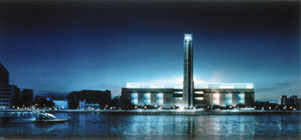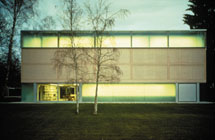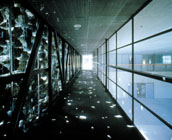|
|
|
MORE THAN A MUSEUM: INVENTING THE 21ST CENTURY ARTS CENTER We have just crossed into a new century, during which the rate and dimension of change promise to test all our powers of invention. Change itself can be measured by the speed of the Internet, which filters an increasingly global network of values and adapts to meet more personalized desires and needs. As a uniquely forward-looking and global arts center with experiential learning at its core, the Walker is well positioned to convert these fluctuations into opportunities. A multidisciplinary arts center that focuses on the visual, performing, and media arts of our time, the Walker is the only major cultural institution in the country persistently engaged in establishing the relationship between artistic activities that occur in the light and dark spaces of galleries and theaters, in real and virtual time, and in our own communities as well as countries as diverse as China, Brazil, South Africa, and Germany. Unlike many museums, the Walker supports innovation through a program of special commissions across the disciplines, many of which have come to be seen as pivotal both to the artist’s career and the history of art. Our focus on multiple disciplines is reflected in the educational programs encompassing the many learning styles of our audiences. Consequently, we are uniquely positioned to participate in the congruence of these disciplines, to expose our visitors to a wide spectrum of related artistic practice across them, to offer our audiences multiple paths into the institution, and to provide artists with research and development opportunities to make new work. Recognizing the challenges our own community faces in maintaining its national stature during this period of rapid change, the Walker Art Center plays a critical role in undergirding the artistic, economic, and social vitality of the region. The Walker is one of the most-visited art museums nationally, and with the Minneapolis Sculpture Garden is among the 10 most popular tourist attractions in Minnesota. Over the last decade, enormous intellectual and financial resources have been directed toward amplifying the Walker’s mission to engage increasingly diverse audiences in the questions that shape and inspire us as individuals, communities, and cultures. The Walker has been singled out by a number of national and local foundations as a leader in developing new audiences, including teens, low-income families, and people of color and for providing a singular environment that brings people together to converse, debate, and experience the ideas and values that stretch our own sense of the world we share. Nearly all of the 20 artists-in-residence whom we host each year are eager to work in partnership with community-based organizations, expanding their artistic vocabulary and attracting new audiences.
With record-breaking attendance of 994,276 visitors during our most recent fiscal year and more than 150,000 visitors each month to our Web site, the Walker now is poised to expand upon its foundation as “one of the foremost museums of modern art, second only in some people’s thinking to the Museum of Modern Art” (the New York Times) in order to invent a new model appropriate to the 21st century. In January 1999, the Walker announced an agreement to purchase the neighboring Allianz Life Insurance Building. The acquisition of this 3.4-acre property, which once included the residence of museum founder T. B. Walker, will allow us to reassemble our original campus and provide us with a wonderful opportunity to significantly expand our facility for the first time since it was built in 1971. After an extensive international search, the Walker selected the renowned Swiss architectural firm Herzog & de Meuron to develop a site plan for the campus and to design the addition. They have come to reconceive the museum not as an enclosed space, but rather as an integral part of the city. As illustrated by their design for the Tate Modern in London, the Walker “is to become a central place in the urban structure, one that attracts people and makes possible a host of experiences,” Herzog says. “Architecture creates its own reality, and is comparable to the autonomous reality of a painting or a sculpture.” Minneapolis-based Hammel, Green, and Abrahamson, Inc. has been selected as the local architectural partner for the project. |
Herzog & de Meuron Tate Modern, London, 1999–2000 Photo: Hayes Davidson |
 Gallery for a Private Collection of Modern Art, Goetz Collection, Munich, Germany, 1992 Photo: Margherita Spiluttini |
 Dominus Winery, Yountville, California, 1997 Photo: Margherita Spiluttini |
|
The desire to create an uplifting destination—perhaps the best public gathering space in the Twin Cities—while expanding the range of artistic, educational, and social experiences we offer on a daily basis provides the motivation for our facility expansion. An unusual urban campus of 17 acres, the new Walker Art Center (scheduled to open during 2005) will include increased indoor and outdoor facilities, allowing us to share more of our resources—from objects in the permanent collection to books in our library to the artist’s own creative process—with our growing audience. Increasingly, this ability to link ideas from different disciplines and art forms is seen as a model for cultural institutions of the future. The planning for our expansion also will encompass the development of a sophisticated infrastructure to support the presentation of art and provide for personalized learning, placing the Walker among the first technologically “smart” cultural facilities in the world.
Our new facilities will reflect the unique multidisciplinary focus of our programs for the first time in the Walker’s history:
Kathy Halbreich
|
|
|